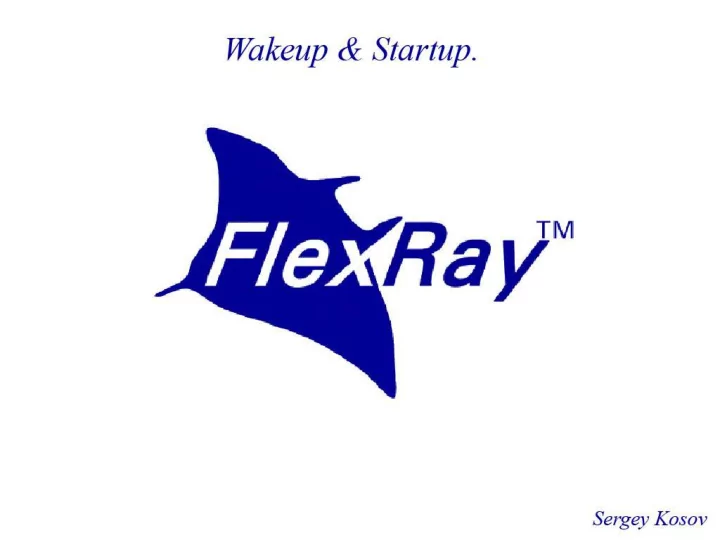

Contents. • General Notes – Node architecture – Wakeup & startup Diagram • Wakeup – Wakeup state diagram • Startup – Coldstart node status – Non-coldstart node status – Cluster startup – Theorem
General Notes. • FlexRay uses TDMA (time-division multiple access) • Clock in cluster must be synchronized. • To bring cluster operational there are Wakeup and Startup states.
Node Architecture.
Wakeup & Startup Diagram.
Wakeup & Startup Diagram.
Wakeup & Startup Diagram.
Wakeup & Startup Diagram.
Wakeup & Startup Diagram.
Wakeup. • Supports any number of nodes that wakeup simultaneously. • At least one node in the cluster needs an external wakeup source. • Node has the ability to transmit a special wakeup pattern . • Wakeup pattern is collision resilient. • Receiving nodes recognizes the wakeup pattern and triggers the node wakeup if it is still asleep. • The node cannot check whether nodes are awake after the transmission of the wakeup pattern.
Wakeup State Diagram.
Wakeup State Diagram. • Inhibit the transmission of the wakeup pattern if there is communication. • When ongoing communication is detected the wakeup attempt is aborted. UNDEFINED Wakeup mechanism was not been executed yet. RECEIVED HEADER Communication detected. RECEIVED WUP (WakeUp Pattern) Wakeup process is already in progress.
Wakeup State Diagram. • The node transmits the wakeup pattern on the configured channel and checks for collision. • If activity is detected during of idle portions, communication controller enters a monitoring phase, to discover the cause of the collision. TRANSMITTED Wakeup pattern was completely transmitted.
Wakeup State Diagram. • The communication controller attempts to discover the reason for the wakeup collision encountered in the previous state. • Listening to channel during specified time. COLLISION HEADER A collision detected by receiving a valid header. COLLISION WUP A collision detected by receiving a valid wakeup pattern. COLLISION UNKNOWN A collision without succeeding valid reception event detected.
Startup. • Sync Frame’s header segment contains an indicator that the deviation measured between the is frame's arrival time and its expected arrival time should be used by the clock synchronization algorithm. • Startup frame’s header segment contains an indicator that integrating nodes may use timerelated information from this frame for initialization during the startup process. • Cluster consists of coldstart and non-coldstart nodes. • Coldstart node is a node capable of initiating the communication startup procedure on the cluster by sending startup frames. • A non-coldstart node requires at least two startup frames from distinct nodes for integration.
Startup. • Sync Frame’s header segment contains an indicator that the deviation measured between the is frame's arrival time and its expected arrival time should be used by the clock synchronization algorithm. • Startup frame’s header segment contains an indicator that integrating nodes may use timerelated information from this frame for initialization during the startup process. • Cluster consists of coldstart and non-coldstart nodes. • Coldstart node is a node capable of initiating the communication startup procedure on the cluster by sending startup frames. • A non-coldstart node requires at least two startup frames from distinct nodes for integration. • Startup Startup performed by the Integration of the non- coldstart nodes. coldstart nodes.
Coldstart Nodes Status.
Coldstart Nodes Status.
Coldstart Nodes Status.
Coldstart Nodes Status.
Coldstart Nodes Status.
Coldstart Nodes Status.
Coldstart Nodes Status.
Coldstart Nodes Status.
Coldstart Nodes Status.
Non - coldstart Nodes Status.
Cluster Startup.
Cluster Startup.
Cluster Startup.
Cluster Startup.
Cluster Startup.
Cluster Startup.
Cluster Startup.
Cluster Startup.
Cluster Startup.
Cluster Startup.
Cluster Startup.
Theorem. • Assumptions: – very node has unique time slot in communication cycle to transmit the satrtup frame. • Conclusion: Given algorithm solves the leader election problem. • Proof: [ T1 ≠ T2 ]⇒ t T1 ≠ t T2 1 case: if t A CAS then t A S ≠ t B CAS = t B S 2 case: CAS ≠ t B CAS t A
Thank you for attantion. Any questions?
Recommend
More recommend